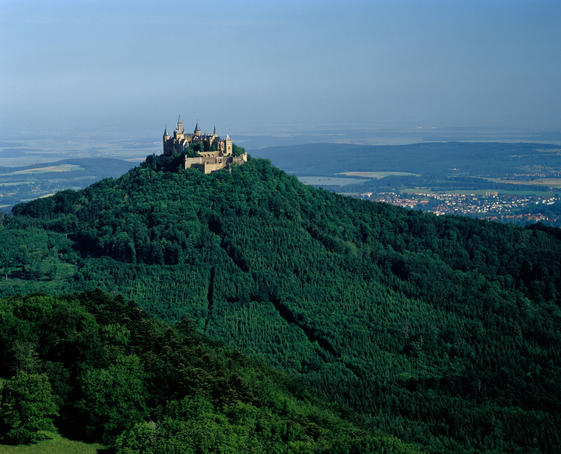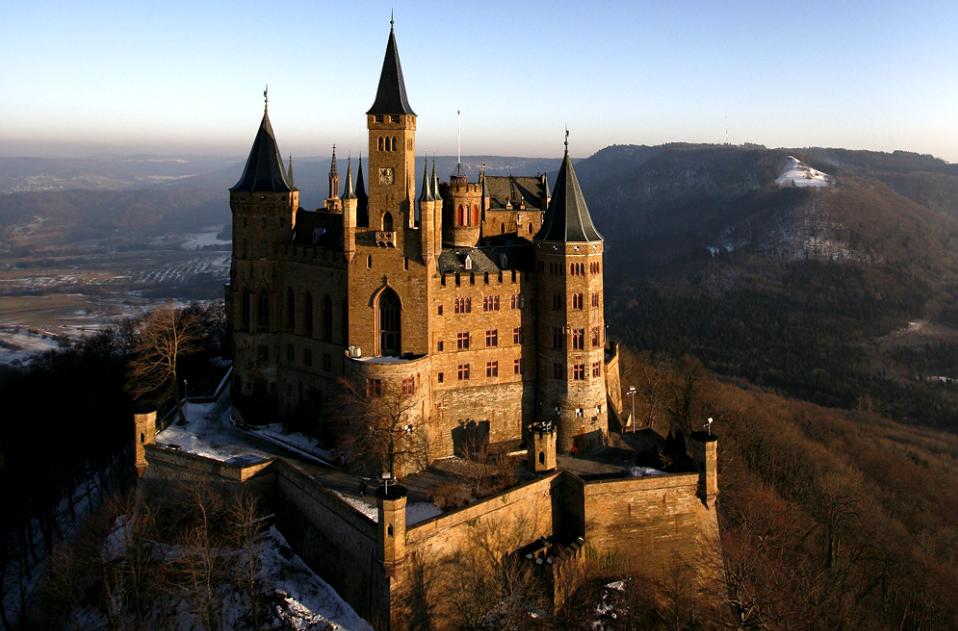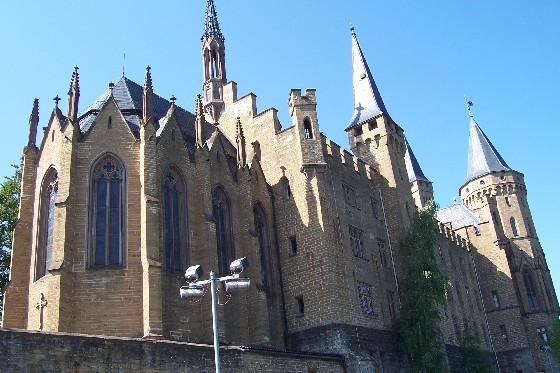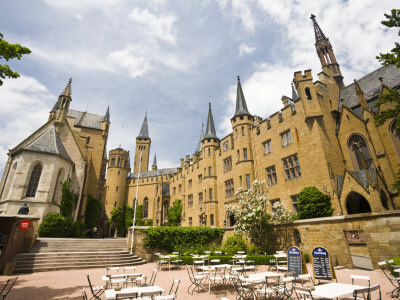
Hohenzollern Castle (German: Burg Hohenzollern) is a castle about 50 kilometers (31 mi) south of Stuttgart, Germany. It is considered the ancestral seat of the Hohenzollern family, which emerged in the Middle Ages and eventually became German Emperors.
The castle is located on top of Mount Hohenzollern at an elevation of 855 meters (2,805 ft) above sea level, 234 m (768 ft) above Hechingen and nearby Bisingen, both located at the foothills of the Swabian Alb. It was originally constructed in the first part of the 11th century.
When the family split into two branches, the castle remained the property of the Swabian branch, which was dynastically senior to the Franconian/Brandenburg branch which eventually acquired an imperial throne. The castle was completely destroyed after a 10-month siege in 1423 by the imperial cities of Swabia. A second, larger and sturdier castle was constructed from 1454 to 1461 and served as a refuge for the Catholic Swabian Hohenzollerns during wartime, including during the Thirty Years' War. By the end of the 18th century, however, the castle was thought to have lost its strategic importance and gradually fell into disrepair, leading to the demolition of several dilapidated buildings. Today, only the chapel remains from the medieval castle.
The third version of the castle, which stands today, was constructed for Frederick William IV of Prussia between 1846 and 1867, under the direction of Friedrich August Stüler, who based his design on English Neo-Gothic style as well as the castles in Loire. Because the castle was built as a family memorial, no member of the Hohenzollern family took residence in this third castle until 1945, when it became home to the last Prussian Crown Prince Wilhelm; he and his wife, Crown Princess Cecilie, are buried there.
Among the historical artifacts of Prussian history contained in the castle today are the Crown of Wilhelm II and some of the personal effects of Frederick the Great and a letter from US President George Washington thanking Baron von Steuben, a scion of the House of Hohenzollern, for his service in the American Revolutionary War. The castle is today a popular tourist destination.
Location
The castle is located on top of Mount Hohenzollern, an isolated mountain 855 m (2,805 ft) above sea level. Among the locals this mountain is known as Zollerberg (Zoller Mountain) or simply as Zoller. Located on the western side of the Swabian Alb region and close to Hechingen, the mountain lends its name to the local geographic region, the Zollernalb.
History
First castle
The first Medieval castle of the House of Hohenzollern was mentioned for the first time in 1267. However the castle appears to date back to the 11th Century. In 1423 the castle was besieged for over a year by troops from the Swabian Free Imperial Cities. On May 15, 1423 the castle was finally taken and totally destroyed. Of the first castle only written records still exist.
Second castle
In 1454 construction on the second castle began. While this castle was much stronger than the first, during the Thirty Years' War (1618–1648) it was captured by Württemberg troops in 1634. Following the Thirty Years' War the castle was under Habsburg control for about a century. During the War of the Austrian Succession (1740–1748) the castle was occupied by French soldiers during the Winter of 1744/45. Following the war, the Habsburgs continued to own the castle, but it was rarely occupied. When the last Austrian owner left the castle in 1798 it began to totally fall to ruins. By the beginning of the 19th Century the castle was a ruin, with only the Chapel of St. Michael remaining usable.
Third castle
The castle was rebuilt by Crown-Prince (and later King) Frederick William IV of Prussia. In 1819 during a trip to Italy, he travelled through southern Germany. During the trip, he wished to learn about his family's roots and climbed to the top of Mount Hohenzollern.
The current castle is the work of the famous Berlin Architect Friedrich August Stüler, who in 1842 while still the student and heir of Karl Friedrich Schinkel was appointed the Architect of the King. The castle is built in the Gothic Revival style. The impressive entryway is the work of the Engineer-Officer Moritz Karl Ernst von Prittwitz who was considered the leading fortifications engineer in Prussia. The sculptures around and inside the castle are the work of Gustav Willgohs. The Hohenzollern Castle is a monument to the ideals of the German Romanticism movement and incorporated the idealized vision of what a medieval knight's castle should be. In this way Hohenzollern Castle is similar to Neuschwanstein Castle in Bavaria, though without the fantastic elements that cover Neuschwanstein. The castle also served to enhance the reputation of the Prussian Royal Family, by rebuilding the ancestral castle in such an ornate form.
Construction began in 1850, and was funded entirely by the Brandenburg-Prussian and the Hohenzollern-Sigmaringen lines of the Hohenzollern family. Seventeen years later construction was completed on October 3, 1867 under William IV's brother King William I. The castle was damaged in an earthquake on September 3, 1978 and was under repair until the mid-1990s.
Function
After the castle was rebuilt, it was not regularly occupied, rather it was used mostly as a show castle. Only the last Prussian Crown Prince William lived in the castle for several months, following his flight from Potsdam during the closing months of World War II. William and his wife Crown Princess Cecilie are both buried at the castle, as the family's estates in Brandenburg had been occupied by the Soviet Union.
Since 1952 the castle has been filled with art and historical artifacts, from the collection of the Hohenzollern family and from the former Hollenzollern Museum in Schloss Monbijou. Two of the major pieces in the collection are the Prussian king's crown and a uniform that belonged to Frederick the Great. From 1952 until 1991 the caskets of Frederick I and Frederick the Great were in the museum. Following the German reunification in 1991, the caskets were moved back to Potsdam.
On 3 September 1978 the Hohenzollern Castle was closed after sustaining extensive damage due to an earthquake in the Swabian Alb. 15 persons were reported injured in Tailfingen, Burladingen and Onstmettingen. 20 people had to be dug out of rubble.
Hohenzollern castle is still privately owned. Two thirds of the castle belongs to the Brandenburg-Prussian line of the Hohenzollern, while one third is owned by the Swabian line of the family. Since 1954 the castle has also been used by the Princess Kira of Prussia Foundation to provide a summer camp for needy children from Berlin. Hohenzollern castle has over 300,000 visitors per year, making it one of the most visited castles in Germany.













0 comments:
Post a Comment